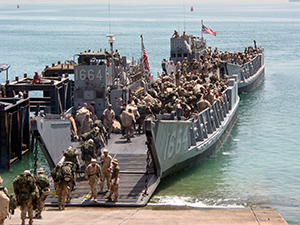 U.S. Marines, from the 24th Marine Expeditionary Unit, patrol in the town of Garmser in Helmand…
U.S. Marines, from the 24th Marine Expeditionary Unit, patrol in the town of Garmser in Helmand…
Here is a stunning paradox: The United States has the most competent and capable military in the world. But that military faces the very real likelihood of collapsing into a hollow, far less capable force. The reasons are hidden in plain sight.
No. 1 is the budget. The fiscal 2015 defense budget requested by the White House totals about $700 billion. However, that level is economically unsustainable for the long term, even as the United States faces a new enemy in the Islamic State. Moreover, sequestration will cut $50 billion a year from defense for 10 years.
The second reason for real worry is the soaring cost for pay, allowances, healthcare, retirees and the gamut of weapons and supporting systems. Unchecked, these costs will increase as much as 40 percent by decade’s end.
If these uncontrolled costs continue, a combination of stunning reductions in force levels, procurement and readiness must follow. When interest rates rise (as eventually they must), that will create massive pressure to cut discretionary spending, of which defense takes the lion’s share. Given this accelerating mismatch between budget and cost growth, how might these inevitable realities be handled?
Annual peacetime defense budgets have averaged between $400 and $450 billion in current dollars. Even if defense spending continues at that level — and that is very unlikely — cost growth will still force huge cuts across all accounts. That will not happen overnight, but it will happen. Hence, Congress must agree to limit this growth by trimming compensation and other personnel costs.
If done rationally — a big if — that means to be well equipped and kept at a relatively high condition of readiness, an active duty force of 800,000 to 900,000 uniform personnel (down from today’s 1.3 million) is sustainable at historical levels of defense spending. That would allow deployment of a total joint force of about 300,000 troops. However, fewer forces and less procurement spending will compress the nation’s large defense industrial base. How can this compression best be managed to maintain a viable future ability to provide the sinews of war?
One solution is to shift conceptually and practically from a defense industrial base to a defense intellectual property base in which producing military hardware and software is secondary to preserving IP, technology and manufacturing assets for these extraordinary combat systems. This transition requires a complementary strategy of regeneration and reconstitution, meaning preserving and paying for certain manufacturing capabilities at minimal production rates, especially research and development, that can be expanded if or when legitimate threats emerge.
This strategy would retain selected nuclear submarines and aircraft carriers, third-generation fighter aircraft, armored vehicles and other systems in a cadre, or reserve status manned with minimal crews — the equivalent of modern-day mothballs. In an emergency, these units could be made operational fairly quickly and fully manned with trained personnel. It also means placing greater emphasis on reserves that may prove less costly than active duty forces.
Despite the pressing need to make tough choices, many will argue that now is not the time to cut defense. Others will argue that Congress will not agree to limit cost growth for compensation, healthcare and retirement. In that case, the result is certain: Our military forces will dramatically shrink in capability and capacity. That would be sinful, but we have sinned before.






Leave A Comment